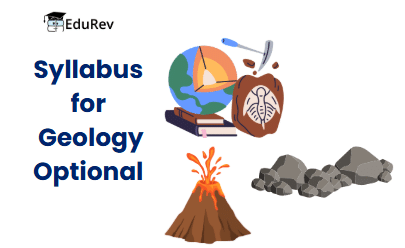UPSC Exam > UPSC Notes > Geology Optional for UPSC > UPSC Optional Subject Syllabus: Geology
UPSC Optional Subject Syllabus: Geology | Geology Optional for UPSC PDF Download
| Table of contents |

|
| Introduction to Geology Optional for UPSC |

|
| Why Choose Geology Optional? |

|
| Paper - I |

|
| Paper - II |

|
| Preparation Strategy |

|
Introduction to Geology Optional for UPSC
The Geology optional for the UPSC Civil Services Examination is a highly specialized and scoring subject, ideal for candidates with a background in Earth Sciences or related fields. Covering topics from general geology to economic geology, it integrates knowledge of Earth's structure, history, and processes, with applications in sustainable development and disaster management. The syllabus is vast but logical, offering a systematic approach to preparation, with a focus on conceptual clarity and diagram-based questions. Geology is particularly advantageous for those interested in addressing contemporary issues like climate change, natural hazards, and resource management.
Why Choose Geology Optional?
- High Scoring Potential: Geology’s scientific and objective nature allows for precise answers, reducing subjectivity and enhancing scoring potential.
- Relevance to Background: Ideal for candidates with a geology or Earth Sciences background, as the syllabus aligns with their academic expertise.
- Overlap with General Studies: Topics like geomorphology, environmental geology, and natural hazards overlap with General Studies Paper I (Geography) and Paper III (Environment), aiding integrated preparation.
- Resource Availability: A wide range of textbooks, field guides, and digital resources are available, ensuring comprehensive syllabus coverage.
- Contemporary Relevance: Geology addresses critical issues like climate change, groundwater management, and sustainable mining, aligning with civil service roles.
- Predictable Question Patterns: Analysis of previous years’ papers shows that UPSC often repeats questions, making preparation more targeted.
Paper - I
General Geology
- The Solar System, Meteorites, Origin and interior of the Earth, Age of Earth
- Volcanoes: Causes, products, volcanic belts
- Earthquakes: Causes, effects, seismic zones of India
- Island arcs, trenches, mid-ocean ridges
- Continental drift, Seafloor spreading, Plate tectonics
- Isostasy
Geomorphology and Remote Sensing
- Basic concepts of geomorphology
- Weathering and soil formations
- Landforms, slopes, and drainage
- Geomorphic cycles and their interpretation
- Morphology and its relation to structures and lithology
- Coastal geomorphology
- Applications of geomorphology in mineral prospecting, civil engineering, hydrology, and environmental studies
- Geomorphology of the Indian subcontinent
- Aerial photographs: Interpretation, merits, and limitations
- The Electromagnetic spectrum
- Orbiting satellites and sensor systems
- Indian Remote Sensing Satellites, Satellite data products
- Applications of remote sensing in geology
- Geographic Information Systems (GIS) and Global Positioning System (GPS): Applications
Structural Geology
- Principles of geologic mapping and map reading
- Projection diagrams
- Stress and strain ellipsoid, stress-strain relationships of elastic, plastic, and viscous materials
- Strain markers in deformed rocks
- Behaviour of minerals and rocks under deformation conditions
- Folds and faults: Classification and mechanics
- Structural analysis of folds, foliations, lineations, joints, faults, unconformities
- Time relationship between crystallization and deformation
Palaeontology
- Species: Definition and nomenclature
- Megafossils and Microfossils
- Modes of preservation of fossils
- Different kinds of microfossils
- Application of microfossils in correlation, petroleum exploration, paleoclimatic, and paleoceanographic studies
- Evolutionary trends in Hominidae, Equidae, and Proboscidae
- Siwalik fauna
- Gondwana flora and fauna and its importance
- Index fossils and their significance
Indian Stratigraphy
- Classification of stratigraphic sequences: Lithostratigraphic, biostratigraphic, chronostratigraphic, and magnetostratigraphic, and their interrelationships
- Distribution and classification of Precambrian rocks of India
- Study of stratigraphic distribution and lithology of Phanerozoic rocks of India with reference to fauna, flora, and economic importance
- Major boundary problems: Cambrian/Precambrian, Permian/Triassic, Cretaceous/Tertiary, Pliocene/Pleistocene
- Study of climatic conditions, paleogeography, and igneous activity in the Indian subcontinent in the geological past
- Tectonic framework of India
- Evolution of the Himalayas
Hydrogeology and Engineering Geology
- Hydrologic cycle and genetic classification of water
- Movement of subsurface water
- Springs; Porosity, permeability, hydraulic conductivity, transmissivity, storage coefficient
- Classification of aquifers
- Water-bearing characteristics of rocks
- Groundwater chemistry, Saltwater intrusion
- Types of wells
- Drainage basin morphometry
- Exploration for groundwater, Groundwater recharge
- Problems and management of groundwater
- Rainwater harvesting
- Engineering properties of rocks
- Geological investigations for dams, tunnels, highways, railways, and bridges
- Rock as a construction material
- Landslides: Causes, prevention, and rehabilitation
- Earthquake-resistant structures
Paper - II
Mineralogy
- Classification of crystals into systems and classes of symmetry
- International system of crystallographic notation
- Use of projection diagrams to represent crystal symmetry
- Elements of X-ray crystallography
- Physical and chemical characters of rock-forming silicate mineral groups
- Structural classification of silicates
- Common minerals of igneous and metamorphic rocks
- Minerals of the carbonate, phosphate, sulphide, and halide groups
- Clay minerals
- Optical properties of common rock-forming minerals
- Pleochroism, extinction angle, double refraction, birefringence, twinning, and dispersion in minerals
Igneous and Metamorphic Petrology
- Generation and crystallization of magmas
- Crystallization of albite-anorthite, diopside-anorthite, and diopside-wollastonite-silica systems
- Bowen’s Reaction Principle
- Magmatic differentiation and assimilation
- Petrogenetic significance of textures and structures of igneous rocks
- Petrography and petrogenesis of granite, syenite, diorite, basic and ultrabasic groups, charnockite, anorthosite, and alkaline rocks
- Carbonatites; Deccan volcanic province
- Types and agents of metamorphism
- Metamorphic grades and zones
- Phase rule
- Facies of regional and contact metamorphism
- ACF and AKF diagrams
- Textures and structures of metamorphic rocks
- Metamorphism of arenaceous, argillaceous, and basic rocks
- Minerals assemblages, Retrograde metamorphism
- Metasomatism and granitisation, migmatites
- Granulite terrains of India
Sedimentary Petrology
- Sediments and sedimentary rocks: Processes of formation, diagenesis, and lithification
- Clastic and non-clastic rocks: Classification, petrography, and depositional environment
- Sedimentary facies and provenance
- Sedimentary structures and their significance
- Heavy minerals and their significance
- Sedimentary basins of India
Economic Geology
- Ore, ore minerals, and gangue; Tenor of ore
- Classification of ore deposits
- Process of formation of mineral deposits
- Controls of ore localization
- Ore textures and structures
- Metallogenic epochs and provinces
- Geology of important Indian deposits of aluminium, chromium, copper, gold, iron, lead-zinc, manganese, titanium, uranium, thorium, and industrial minerals
- Deposits of coal and petroleum in India
- National Mineral Policy
- Conservation and utilization of mineral resources
- Marine mineral resources and Law of Sea
Mining Geology
- Methods of prospecting: Geological, geophysical, geochemical, and geobotanical
- Techniques of sampling
- Estimation of reserves of ore
- Methods of exploration and mining: Metallic ores, industrial minerals, marine mineral resources, and building stones
- Mineral beneficiation and ore dressing
Geochemistry and Environmental Geology
- Cosmic abundance of elements
- Composition of planets and meteorites
- Structure and composition of Earth and distribution of elements
- Trace elements
- Elements of crystal chemistry: Types of chemical bonds, coordination number
- Isomorphism and polymorphism
- Elementary thermodynamics
- Natural hazards: Floods, mass wasting, coastal hazards, earthquakes, volcanic activity, and mitigation
- Environmental impact of urbanization, mining, industrial and radioactive waste disposal, use of fertilizers, dumping of mine waste and fly ash
- Pollution of ground and surface water, marine pollution
- Environmental protection: Legislative measures in India
- Sea level changes: Causes and impact
Recommended Resources
- General Geology: "General Geology" by G.B. Mahapatra
- Geomorphology: "Geomorphology" by Savindra Singh, "Geomorphology" by Thornbury
- Structural Geology: "Structural Geology" by Marland P. Billings
- Paleontology: "The Elements of Paleontology" by Rhona M. Black
- Indian Stratigraphy: "Geology of India" by M. Ramakrishnan and R. Vaidyanadhan
- Economic Geology: "Economic Geology" by U. Prasad, "Ore Deposits of India" by Roy Chaudhary
- Previous Year Question Papers: 2018-2024 Questions
- Online Study Material: Geology Optional Notes
Preparation Strategy
- Understand the Syllabus: Thoroughly review the syllabus for both Paper I and II to prioritize high-weightage topics. Paper I, Paper II
- Focus on Diagrams: Practice drawing geological maps, cross-sections, and crystal structures to enhance answer presentation.
- Link with Current Affairs: Relate topics like natural hazards and environmental geology to recent events for enriched answers.
- Answer Writing Practice: Write concise, diagram-supported answers to improve clarity and time management.
- Mock Tests: Regularly attempt mock tests to simulate exam conditions and assess preparation.
- Revise Previous Year Questions: UPSC often repeats questions, so revising past papers is critical for predicting trends. 2024, 2023, 2022, 2021, 2020, 2019, 2018
The document UPSC Optional Subject Syllabus: Geology | Geology Optional for UPSC is a part of the UPSC Course Geology Optional for UPSC.
All you need of UPSC at this link: UPSC
|
32 videos|135 docs
|
FAQs on UPSC Optional Subject Syllabus: Geology - Geology Optional for UPSC
| 1. What is the syllabus for the Geology optional subject in the UPSC exam? |  |
Ans. The syllabus for the Geology optional subject in the UPSC exam includes topics such as general geology, geomorphology, structural geology, paleontology, stratigraphy, mineralogy, igneous and metamorphic petrology, sedimentology, and economic geology.
| 2. How many papers are there in the UPSC exam for Geology optional subject? |  |
Ans. There are two papers in the UPSC exam for the Geology optional subject. Paper-I covers topics like general geology, geomorphology, structural geology, and paleontology. Paper-II includes topics such as stratigraphy, mineralogy, igneous and metamorphic petrology, sedimentology, and economic geology.
| 3. Are there any recommended books or study materials for the Geology optional subject in the UPSC exam? |  |
Ans. Yes, there are several recommended books and study materials for the Geology optional subject in the UPSC exam. Some popular ones include "A Textbook of Geology" by P.K. Mukherjee, "Principles of Engineering Geology" by K.M. Bangar, and "Textbook of Physical Geology" by G.B. Mahapatra.
| 4. How can I prepare for the Geology optional subject in the UPSC exam? |  |
Ans. To prepare for the Geology optional subject in the UPSC exam, it is recommended to start by thoroughly studying the syllabus and understanding the exam pattern. It is important to make a study plan, allocate specific time for each topic, and revise regularly. Additionally, solving previous years' question papers and taking mock tests can help in familiarizing oneself with the exam format and improving time management skills.
| 5. Is it necessary to have a background in Geology to choose it as an optional subject in the UPSC exam? |  |
Ans. While having a background in Geology can be advantageous, it is not mandatory to choose it as an optional subject in the UPSC exam. With proper dedication, hard work, and effective preparation, candidates from various backgrounds can excel in the Geology optional subject. It is essential to have a genuine interest in the subject and a willingness to put in the required effort to understand and grasp the concepts.
Related Searches
















